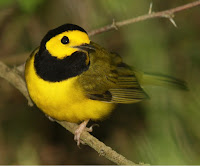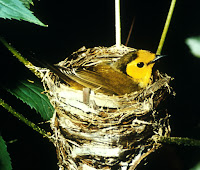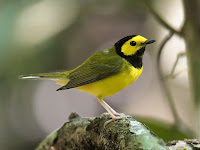HOODED WARBLER
HOODED WARBLER – (Setophaga citrina) – (See images below)
DESCRIPTION: The Hooded Warbler breeding male has a bright yellow forehead, face and under parts. Head cap, neck and throat are black. Back, wings and tail are olive green. Adult female is washout out version of breeding male. First year female/immature have an olive head and back, with some grey on wings and tail. Under parts are dull yellow. Eyes are black, bill is dark grey, legs are pinkish grey. Bird length is around 13 cm (5 inches).
VOICE: https://www.xeno-canto.org/species/Setophaga-citrina
NAME: ‘Warbler’ means ‘to sing with trills and quavers’. ‘Hooded’ refers to the head plumage. Latin genus name ‘Setophaga’ means ‘to eat moths’, in reference to the bird’s diet. Latin species name ‘citrina’ refers to a shade of yellow.
HABITAT: Forest undergrowth.
DIET: Insects, spiders.
NESTING: Nest is built in a shrub near the ground. Around four whitish eggs are laid, incubated by female. Chicks fed by both parents. Nest is often parasitized by Brown-headed Cowbird.
DISTRIBUTION: Breeds in southeast USA (except Florida). Winters in the Caribbean and along southeast coast of Mexico including the Yucatan Peninsula.
Distribution Map: https://en.wikipedia.org/wiki/Hooded_warbler – /media/File:Wilsonia_citrina_map.svg
ON PEI: Does not breed on Prince Edward Island, sightings listed as ‘accidental’ so far. See note below on bird vagrancy.
CONSERVATION: Population large and increasing, not at risk.
NOTES: On its wintering grounds this warbler is still territorial, and territories are specific to each sex.
Vagrancy: In biology this means an animal going way outside its normal range. For birds, this can happen when there are storms and they get blown off course. On other times, the bird simply wanders in a different direction than usual. Here’s an article about vagrancy in birds.
SIMILAR SPECIES: Yellow Warbler, Wilson’s Warbler
REFERENCES: https://nature.mdc.mo.gov/discover-nature/field-guide/hooded-warbler (Missouri Department of Conservation)
American Bird Conservancy (Hooded Warbler)http://identify.whatbird.com/obj/300/overview/Hooded_Warbler.aspx
https://en.wikipedia.org/wiki/Hooded_warbler
http://fieldguide.mt.gov/speciesDetail.aspx?elcode=ABPBX16010 (Montana Field Guide)
https://animaldiversity.org/accounts/Wilsonia_citrina/ (University of Michigan)
https://www.audubon.org/field-guide/bird/hooded-warbler
https://txtbba.tamu.edu/species-accounts/hooded-warbler/ (Texas Breeding Bird Atlas)
https://www.allaboutbirds.org/guide/Hooded_Warbler/lifehistory
DESCRIPTION: The Hooded Warbler breeding male has a bright yellow forehead, face and under parts. Head cap, neck and throat are black. Back, wings and tail are olive green. Adult female is washout out version of breeding male. First year female/immature have an olive head and back, with some grey on wings and tail. Under parts are dull yellow. Eyes are black, bill is dark grey, legs are pinkish grey. Bird length is around 13 cm (5 inches).
VOICE: https://www.xeno-canto.org/species/Setophaga-citrina
NAME: ‘Warbler’ means ‘to sing with trills and quavers’. ‘Hooded’ refers to the head plumage. Latin genus name ‘Setophaga’ means ‘to eat moths’, in reference to the bird’s diet. Latin species name ‘citrina’ refers to a shade of yellow.
HABITAT: Forest undergrowth.
DIET: Insects, spiders.
NESTING: Nest is built in a shrub near the ground. Around four whitish eggs are laid, incubated by female. Chicks fed by both parents. Nest is often parasitized by Brown-headed Cowbird.
DISTRIBUTION: Breeds in southeast USA (except Florida). Winters in the Caribbean and along southeast coast of Mexico including the Yucatan Peninsula.
Distribution Map: https://en.wikipedia.org/wiki/Hooded_warbler – /media/File:Wilsonia_citrina_map.svg
ON PEI: Does not breed on Prince Edward Island, sightings listed as ‘accidental’ so far. See note below on bird vagrancy.
CONSERVATION: Population large and increasing, not at risk.
NOTES: On its wintering grounds this warbler is still territorial, and territories are specific to each sex.
Vagrancy: In biology this means an animal going way outside its normal range. For birds, this can happen when there are storms and they get blown off course. On other times, the bird simply wanders in a different direction than usual. Here’s an article about vagrancy in birds.
SIMILAR SPECIES: Yellow Warbler, Wilson’s Warbler
REFERENCES: https://nature.mdc.mo.gov/discover-nature/field-guide/hooded-warbler (Missouri Department of Conservation)
American Bird Conservancy (Hooded Warbler)http://identify.whatbird.com/obj/300/overview/Hooded_Warbler.aspx
https://en.wikipedia.org/wiki/Hooded_warbler
http://fieldguide.mt.gov/speciesDetail.aspx?elcode=ABPBX16010 (Montana Field Guide)
https://animaldiversity.org/accounts/Wilsonia_citrina/ (University of Michigan)
https://www.audubon.org/field-guide/bird/hooded-warbler
https://txtbba.tamu.edu/species-accounts/hooded-warbler/ (Texas Breeding Bird Atlas)
https://www.allaboutbirds.org/guide/Hooded_Warbler/lifehistory
 |
| Hooded warbler breeding male, TX by Tony Castro, June 2017 |
 |
| Hooded warbler female on nest, USFWS |
 |
| Hooded warbler, 1st year female, TX by Tony Castro, Apr. 2014 |
 |
| Hooded warbler breeding male, Mexico by Ninahale, Apr. 2019 |